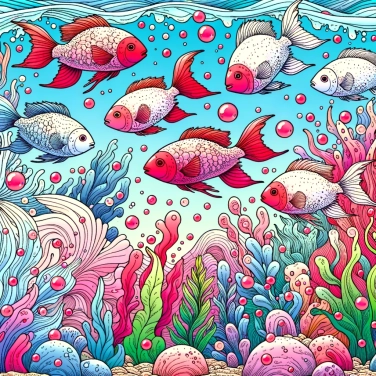The gills are red due to the presence of pigments called hemoglobin, which transport oxygen in the blood of fish and give them this characteristic color.

Gills are somewhat like lungs for us, except that they work underwater. They are generally made up of thin filaments that are highly vascularized with tiny blood vessels called capillaries. These filaments directly capture the dissolved oxygen in the water while blood circulates. Since they are packed with these small blood vessels, they have a naturally reddish-pink hue. The blood arrives low in oxygen, circulates through the gill filaments, and leaves oxygen-rich back to the rest of the body. It is precisely these small blood capillaries filled with oxygen-rich blood that give the characteristic bright red color of healthy gills.
Gills contain a protein called hemoglobin, found in the blood of most animals (and in ours too, by the way). This molecule carries oxygen in the body. What you need to know is that hemoglobin is red due to the iron it contains. When it binds with oxygen, it gives a bright red hue, which explains why well-oxygenated gills appear so red in healthy fish. Without oxygen, hemoglobin turns dark red, even leaning towards purple (you've probably noticed this difference with your own blood). So, the more oxygen there is, the redder the gills become.
When the blood of a fish passes through the gills, it turns bright red because it captures a lot of oxygen. The more oxygen-rich the blood is, the brighter the hemoglobin (the molecule that carries oxygen) becomes. Conversely, when the oxygen is low, such as in stagnant or poorly oxygenated water, the gills take on a dark red color, sometimes almost brown. Simple: a lot of oxygen = bright red, little oxygen = dark. Some fishermen even look at the color of the gills to check if a fish is fresh.
The color of the gills can vary depending on certain environmental conditions, particularly the water quality. For example, if the water contains low levels of dissolved oxygen, the gills may become less bright red or even dark, indicating respiratory stress in the fish. The presence of chemical pollutants or toxins also reduces respiratory efficiency, often giving the gills a less healthy appearance and a dark reddish or brownish color. Conversely, ideal conditions with plenty of available oxygen result in beautifully bright red gills, indicating a healthy fish in a clean environment.
The gills are not only used to capture dissolved oxygen: some fish also use their gills to regulate their levels of salts and minerals, a process that indirectly influences their coloration.
Ammonia or other pollutants in the water can darken or alter the original color of the gills, serving as a practical indicator of water quality for aquarists or aquatic biologists.
Fresh fish specimens typically have bright red gills, while dull or brown colors may be a sign of lack of freshness or poor preservation.
In addition to fish, crustaceans such as certain crabs also have gill structures to breathe underwater, but they are generally not red due to the difference in hemolymph (the equivalent of blood in these animals), which is low in hemoglobin.
Several environmental conditions, such as oxygen levels, temperature, and water quality, can influence the color of gills. Water low in oxygen causes fish to increase their blood flow, initially making their gills very red, and then eventually paler in cases of prolonged stress.
Pale or whitish gills generally indicate a health problem in fish. This may suggest a lack of oxygen in the water, prolonged stress, a parasitic infection, or a disease affecting the circulatory or respiratory system.
Yes, the color and appearance of the gills can vary with age. In young fish, the gills are usually bright red and thin, optimizing oxygenation. In older fish, they may become paler, thicker, or show some variations in tone, indicating less optimal oxygenation.
Out of the water, the gill filaments stick together and lose respiratory efficiency. This leads to an accumulation of oxygen-rich blood in the gill tissues, temporarily intensifying the red color of the gills.
In general, yes. Bright red gills indicate that the fish has a good level of oxygenation and that its blood is circulating effectively. However, excessive redness or a sudden change in color could signal inflammation or infection.
No, the color of the gills mainly depends on the hemoglobin present in the blood. Some species have a different pigment or alternative respiratory systems, which give them varied shades ranging from grayish to dark brown, and even bluish.

No one has answered this quiz yet, be the first!' :-)
Question 1/5